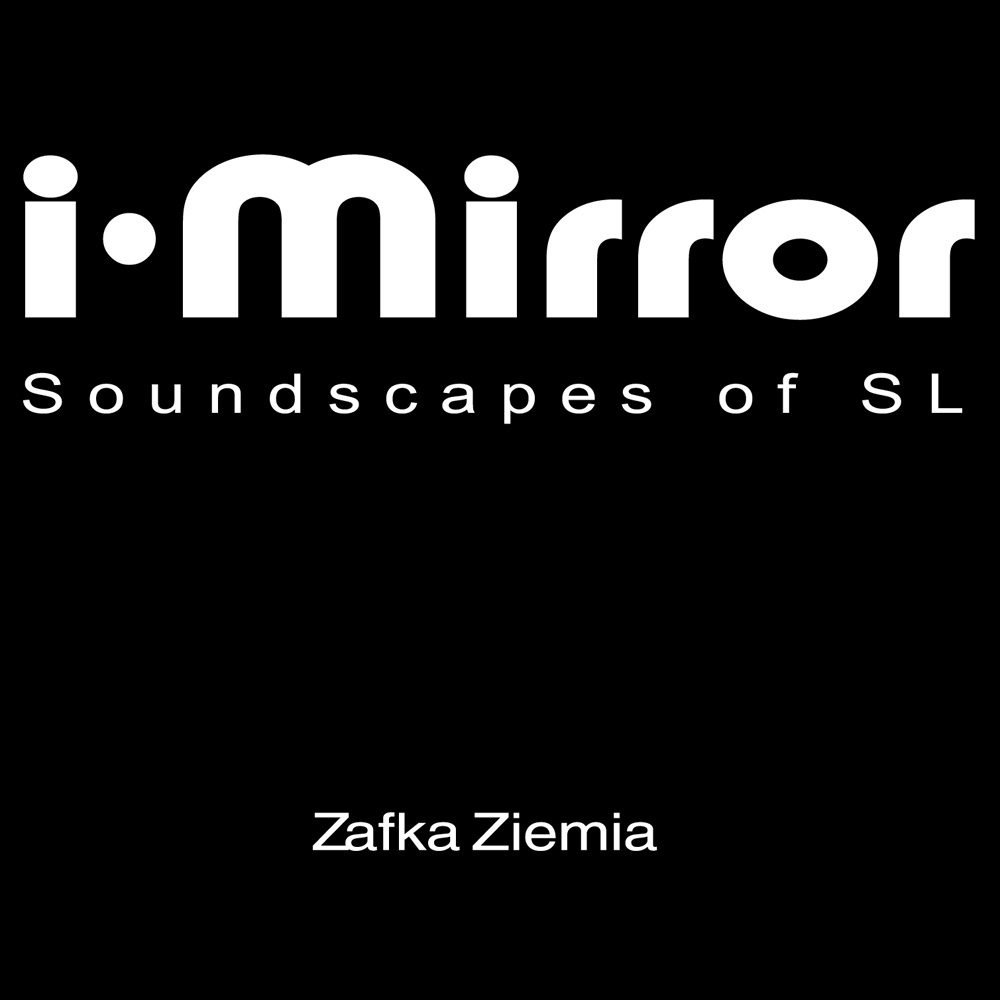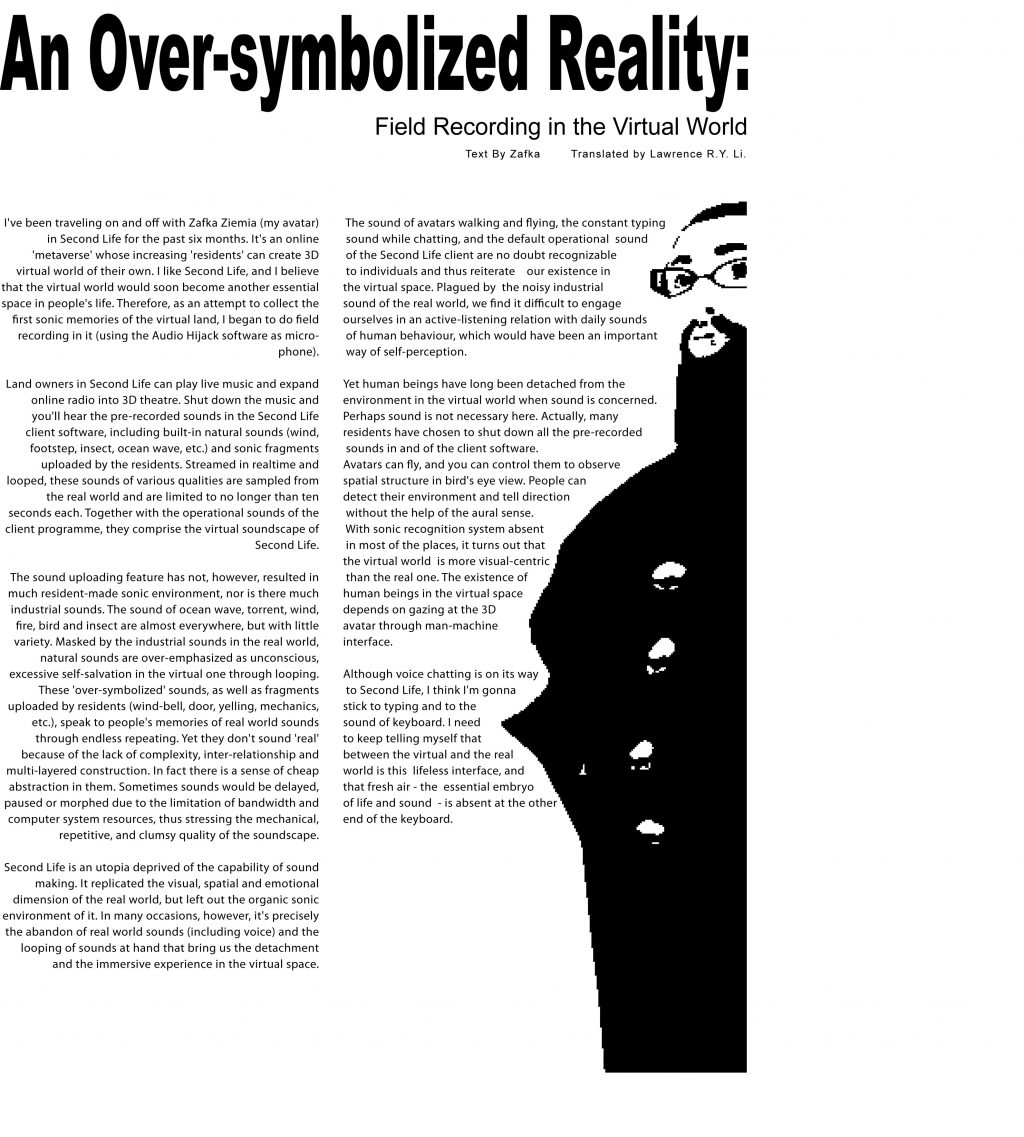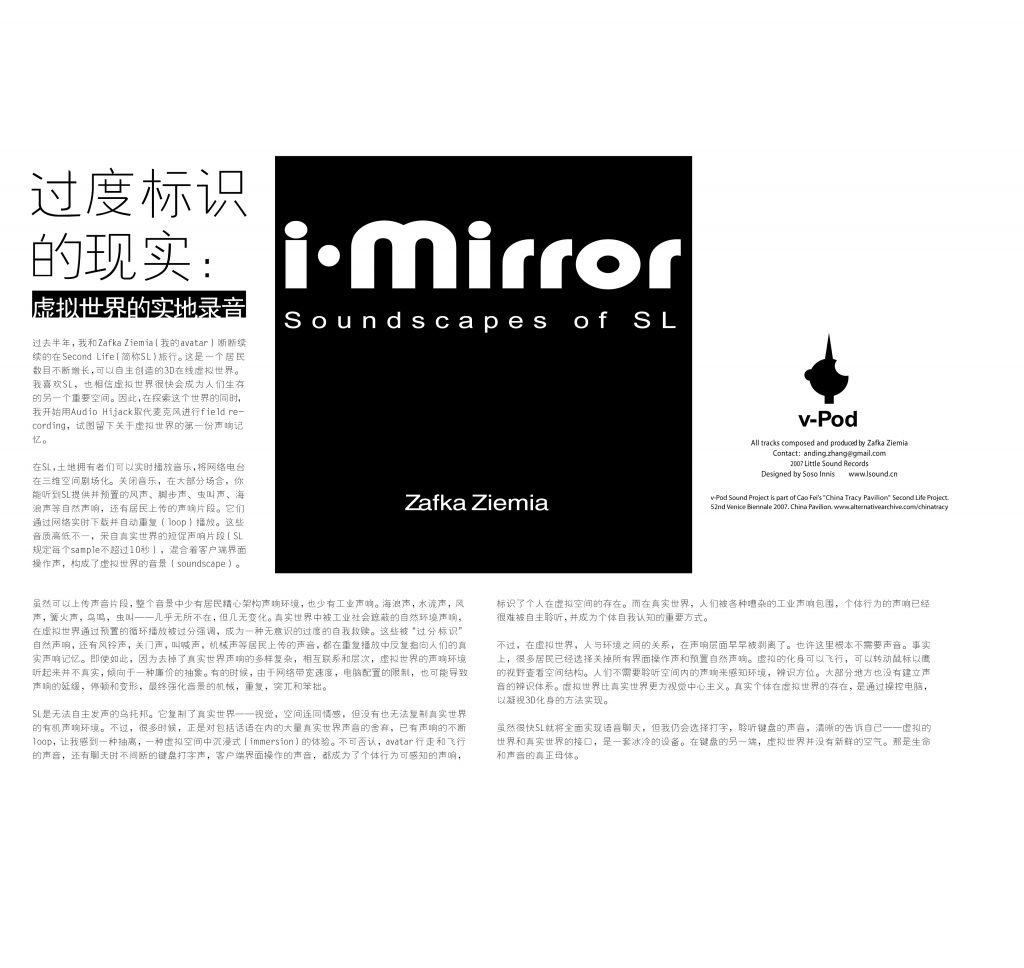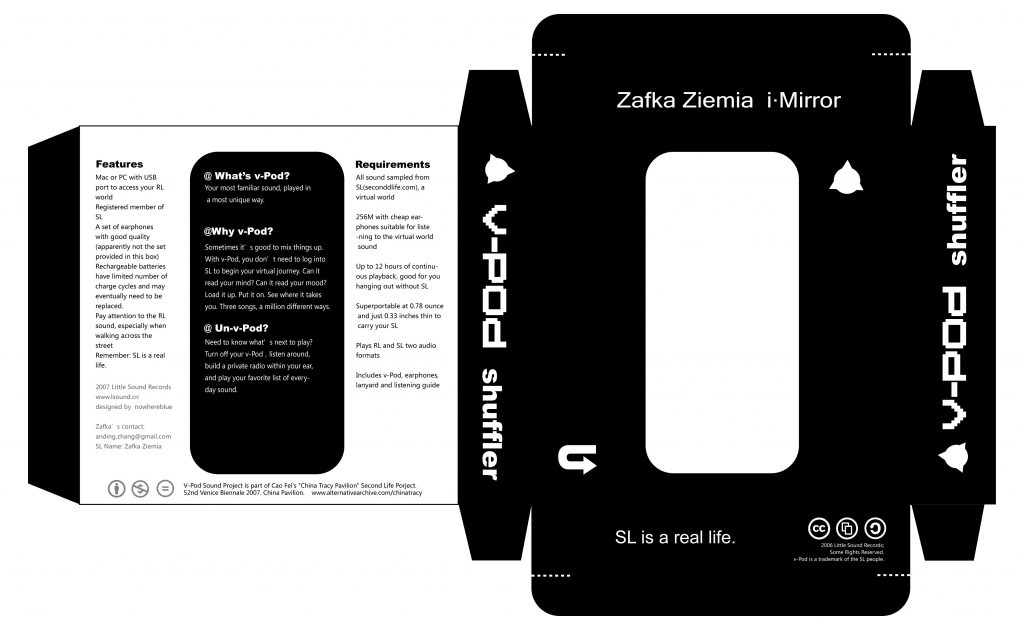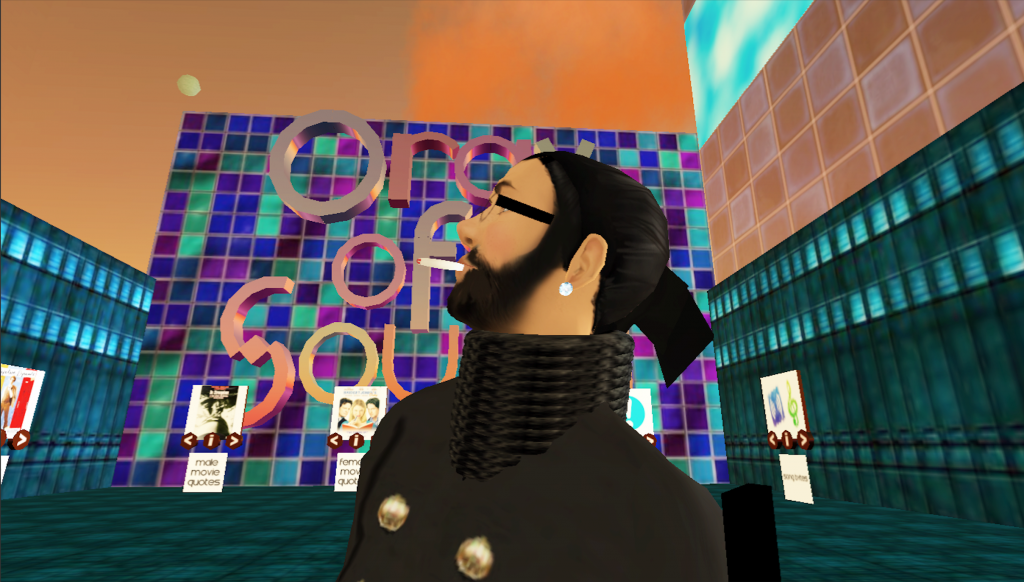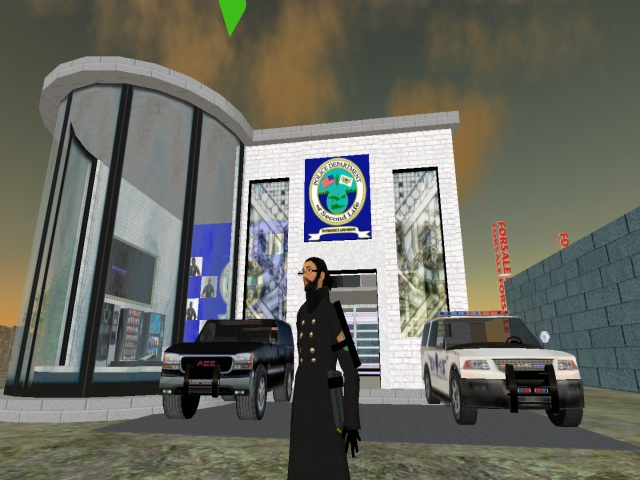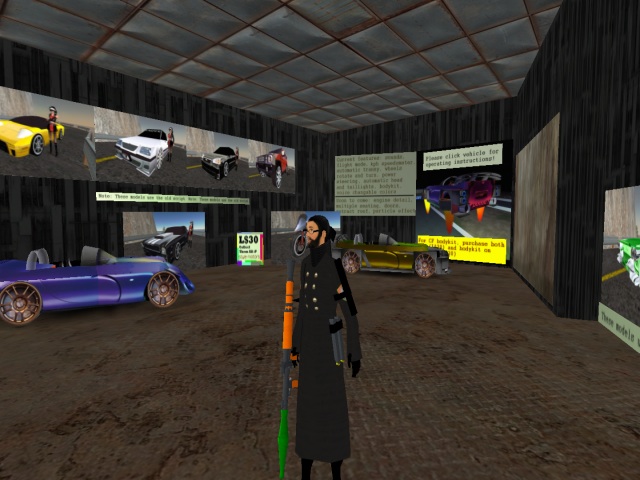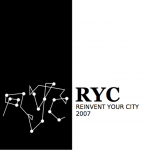第二人生的音景 i·Mirror: Soundscapes of SL
2007 基于在线3D虚拟世界Second Life的田野录音作曲和声音装置
* 该作品为艺术家曹斐在2007年威尼斯双年展作品 “i.mirror”的声音装置部分,以及影像的声音设计部分。
大概2006年,我成为了3D虚拟世界Second Life(第二人生)的用户。我花了很多时间在SL玩儿,对SL的社会和文化进行研究,也开始写作当时第一个专注在SL的中文博客,以及在《城市中国》杂志开设探讨虚拟世界的“平行世界”专栏。我当时甚至换了一份工作,加入了中国本土的3D虚拟世界创业公司HiPiHi,研究产业和社区政策,联结到了当时很多全球的虚拟世界的投资者和从业者。我开始把线上虚拟世界,看成是线下世界田野的扩展和延伸。
2007年,基于在SL虚拟世界的研究以及田野录音,我制作了新的唱片。
—————————————————————-
过度符号化的现实:虚拟世界的实地录音 文 / Zafka
过去半年,我和Zafka Ziemia(我的avatar)断断续续的在Second Life(简称SL)旅行。这是一个居民数目不断增长,可以自主创造的3D在线虚拟世界。我喜欢SL,也相信虚拟世界很快会成为人们生存的另一个重要空间。因此,在探索这个世界的同时,我开始用Audio Hijack取代麦克风进行field recording,试图留下关于虚拟世界的第一份声响记忆。
在SL,土地拥有者们可以实时播放音乐,将网络电台在三维空间剧场化。关闭音乐,在大部分场合,你能听到SL提供并预置的风声,脚步声,虫叫声,海浪声等自然声响,还有居民上传的声响片段。它们通过网络实时下载并自动重复(loop)播放。这些音质高低不一,采自真实世界的短促声响片段(SL规定每个sample不超过10秒),混合着客户端界面操作声,构成了虚拟世界的音景(soundscape)。
虽然可以上传声音片段,整个音景中少有居民精心架构声响环境,也少有工业声响。海浪声,水流声,风声,篝火声,鸟鸣,虫叫——几乎无所不在,但几无变化。真实世界中被工业社会遮蔽的自然环境声响,在虚拟世界通过预置的循环播放被过分强调,成为一种无意识的过度的自我救赎。这些被“过分标识”自然声响,还有风铃声,关门声,叫喊声,机械声等居民上传的声音,都在重复播放中反复指向人们的真实声响记忆。即使如此,因为去掉了真实世界声响的多样复杂,相互联系和层次,虚拟世界的声响环境听起来并不真实,倾向于一种廉价的抽象。有的时候,由于网络带宽速度,电脑配置的限制,也可能导致声响的延缓,停顿和变形,最终强化音景的机械,重复,突兀和笨拙。
SL是无法自主发声的乌托邦。它复制了真实世界——视觉,空间连同情感,但没有也无法复制真实世界的有机声响环境。不过,很多时候,正是对包括话语在内的大量真实世界声音的舍弃,已有声响的不断loop,让我感到一种抽离,一种虚拟空间中沉浸式(immersion)的体验。不可否认,avatar行走和飞行的声音,还有聊天时不间断的键盘打字声,客户端界面操作的声音,都成为了个体行为可感知的声响,标识了个人在虚拟空间的存在。而在真实世界,人们被各种嘈杂的工业声响包围,个体行为的声响已经很难被自主聆听,并成为个体自我认知的重要方式。
不过,在虚拟世界,人与环境之间的关系,在声响层面早早被剥离了。也许这里根本不需要声音。事实上,很多居民已经选择关掉所有界面操作声和预置自然声响。虚拟的化身可以飞行,可以转动鼠标以鹰的视野查看空间结构。人们不需要聆听空间内的声响来感知环境,辨识方位。大部分地方也没有建立声音的辨识体系。虚拟世界比真实世界更为视觉中心主义。真实个体在虚拟世界的存在,是通过操控电脑,以凝视3D化身的方法实现。
虽然很快SL就将全面实现语音聊天,但我仍会选择打字,聆听键盘的声音,清晰的告诉自己——虚拟的世界和真实世界的接口,是一套冰冷的设备。在键盘的另一端,虚拟世界并没有新鲜的空气。那是生命和声音的真正母体。
Around 2006, I became a user of Second Life, a 3D online virtual world. I spent a lot of time playing in SL, doing research on SL’s society and culture, and started writing the first Chinese blog dedicated to SL at the time, as well as a virtual world column in Urban China magazine. At that time, I even changed a job and joined HiPiHi, a local 3D virtual world startup in China. I am responsible for researching industry and community policy. I connected with many global virtual world investors and practitioners at that time. I began to see the online virtual world as an extension of the offline world. In 2007, I made a new record based on my research and field recordings in the SL. At the same time, the work was also presented as the sound installation part of artist Cao Fei’s work “i.mirror” at the 2007 Venice Biennale, as well as the sound design part of her video work.
An Over-symbolized Reality: Field Recording in the Virtual World (By Zafka)
I’ve been traveling on and off with Zafka Ziemia (my avatar) in Second Life for the past six months. It’s an online ‘metaverse’ whose increasing ‘residents’ can create 3D virtual world of their own. I like Second Life, and I believe that the virtual world would soon become another essential space in people’s life. Therefore, as an attempt to collect the first sonic memories of the virtual land, I began to do field recording in it (using the Audio Hijack software as microphone).
Land owners in Second Life can play live music and expand online radio into 3D theatre. Shut down the music and you’ll hear the pre-recorded sounds in the Second Life client software, including built-in natural sounds (wind, footstep, insect, ocean wave, etc.) and sonic fragments uploaded by the residents. Streamed in realtime and looped, these sounds of various qualities are sampled from the real world and are limited to no longer than ten seconds each. Together with the operational sounds of the client programme, they comprise the virtual soundscape of Second Life.
The sound uploading feature has not, however, resulted in much resident-made sonic environment, nor is there much industrial sounds. The sound of ocean wave, torrent, wind, fire, bird and insect are almost everywhere, but with little variety. Masked by the industrial sounds in the real world, natural sounds are over-emphasized as unconscious, excessive self-salvation in the virtual one through looping. These ‘over-symbolized’ sounds, as well as fragments uploaded by residents (wind-bell, door, yelling, mechanics, etc.), speak to people’s memories of real world sounds through endless repeating. Yet they don’t sound ‘real’ because of the lack of complexity, inter-relationship and multi-layered construction. In fact there is a sense of cheap abstraction in them. Sometimes sounds would be delayed, paused or morphed due to the limitation of bandwidth and computer system resources, thus stressing the mechanical, repetitive, and clumsy quality of the soundscape.
Second Life is an utopia deprived of the capability of sound making. It replicated the visual, spatial and emotional dimension of the real world, but left out the organic sonic environment of it. In many occasions, however, it’s precisely the abandon of real world sounds (including voice) and the looping of sounds at hand that bring us the detachment and the immersive experience in the virtual space. The sound of avatars walking and flying, the constant typing sound while chatting, and the default operational sound of the Second Life client are no doubt recognizable to individuals and thus reiterate our existence in the virtual space. Plagued by the noisy industrial sound of the real world, we find it difficult to engage ourselves in an active-listening relation with daily sounds of human behaviour, which would have been an important way of self-perception.
Yet human beings have long been detached from the environment in the virtual world when sound is concerned. Perhaps sound is not necessary here. Actually, many residents have chosen to shut down all the pre-recorded sounds in and of the client software. Avatars can fly, and you can control them to observe spatial structure in bird’s eye view. People can detect their environment and tell direction without the help of the aural sense. With sonic recognition system absent in most of the places, it turns out that the virtual world is more visual-centric than the real one. The existence of human beings in the virtual space depends on gazing at the 3D avatar through man-machine interface.
Although voice chatting is on its way to Second Life, I think I’m gonna stick to typing and to the sound of keyboard. I need to keep telling myself that between the virtual and the real world is this lifeless interface, and that fresh air – the essential embryo of life and sound – is absent at the other end of the keyboard.
(Translated by Lawrence R.Y. Li.)
